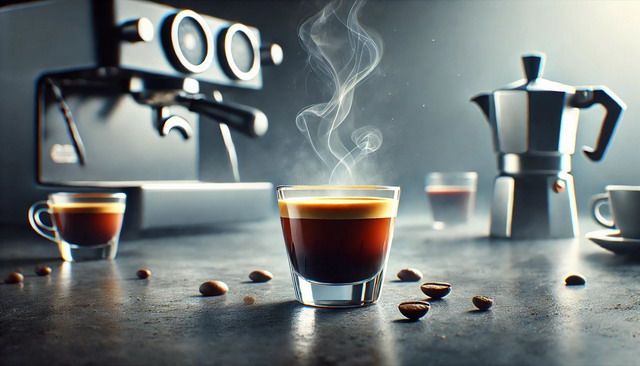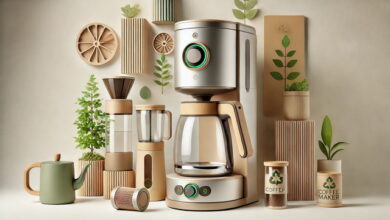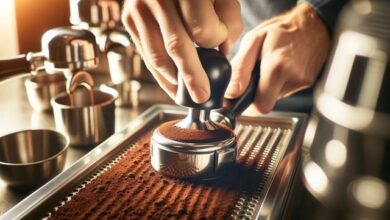Caffeine in Double Shot Espresso: How Much Boost Does It Really Give?
Caffeine in Double Shot Espresso
There’s something undeniably enticing about the rich aroma of a freshly brewed double shot espresso. For many, it’s the ultimate pick-me-up, a concentrated burst of caffeine wrapped in velvety smooth coffee crema. Whether you’re a busy professional rushing to your morning meeting or a coffee connoisseur savoring each sip, the double shot espresso has cemented its place in the hearts of caffeine lovers worldwide.
But what exactly is a double shot espresso? At its core, an espresso is a coffee brewing method that forces a small amount of nearly boiling water through finely-ground coffee beans under high pressure. This process results in a dense, aromatic shot of coffee, typically served in small, concentrated portions. A double shot, also known as a “doppio,” simply means two shots of espresso extracted simultaneously using double the amount of coffee grounds. This doubles the intensity and, of course, the caffeine content.
Historically, espresso originated in Italy during the early 20th century, becoming a staple of Italian café culture. Its invention was driven by a need for speed—a quicker way to brew coffee, hence the name “espresso,” which means “fast” in Italian. Over the decades, the espresso shot has transcended borders, making its way into coffeehouses, kitchens, and cafés around the world. Today, it is the foundation of many popular drinks like cappuccinos, lattes, and Americanos. Yet, the simple double shot remains a pure, unadulterated experience for those who want to appreciate the essence of the coffee bean.
For many, the appeal of the double shot espresso lies in its bold flavor and high caffeine content. But just how much caffeine does it pack, and what should you know before making it your go-to drink? Let’s dive into the numbers and explore what sets a double shot apart.
How Much Caffeine is in a Double Shot Espresso?
When you’re reaching for that double shot espresso, it’s usually because you’re looking for a quick and efficient caffeine boost. But how much caffeine are you really consuming? The answer can vary depending on a range of factors, but on average, a double shot of espresso contains anywhere between 120 to 150 milligrams of caffeine.
To put this in perspective, a standard 8-ounce cup of drip coffee contains roughly 95 milligrams of caffeine. While espresso has more caffeine per ounce than drip coffee, the smaller serving size means that the total caffeine content of a double shot is roughly comparable to a full cup of coffee. However, because espresso is consumed in a much shorter period, the caffeine enters your bloodstream more quickly, giving you that immediate, invigorating jolt.
Factors Influencing Caffeine Levels in Espresso
The caffeine content of your double shot espresso is not a fixed number. Several variables can influence just how much caffeine ends up in your cup. These include:
- Type of Coffee Bean: There are two main types of coffee beans used in espresso: Arabica and Robusta. Arabica beans, known for their smooth and complex flavors, contain less caffeine than Robusta beans, which have a more bitter taste and higher caffeine content. A double shot made with Robusta beans will pack a stronger caffeine punch than one made with Arabica.
- Roast Level: The darker the roast, the less caffeine the beans retain. While a dark roast espresso may have a bolder flavor, it likely contains slightly less caffeine than a medium or light roast. If you’re seeking maximum caffeine, opting for a lighter roast might be the way to go.
- Grind Size and Brewing Time: Espresso requires a fine grind to extract the right balance of flavors and caffeine during the brewing process. The grind size can affect extraction; if the grind is too coarse, less caffeine will be extracted, and if it’s too fine, you may end up over-extracting the coffee, resulting in a bitter taste. Brewing time also matters—too short, and you’ll miss out on the full caffeine potential; too long, and you’ll end up with a bitter, over-extracted shot.
- Water Temperature and Pressure: The ideal espresso brewing temperature is around 195 to 205°F (90 to 96°C). Water that’s too hot can burn the grounds, leading to a bitter shot, while water that’s too cold will under-extract, leaving much of the caffeine behind. Proper pressure, typically around 9 bars, ensures that the caffeine and flavors are fully extracted from the grounds.
Double Shot Espresso vs. Regular Coffee
One of the most frequent comparisons people make is between espresso and regular drip coffee. If you’re drinking coffee for its caffeine content, you might be wondering which packs the bigger punch. While espresso has a higher concentration of caffeine per ounce, drip coffee often has a larger total volume, meaning a typical cup of coffee contains more caffeine than a single shot of espresso. However, because a double shot is two servings of espresso, it levels the playing field with a standard 8-ounce cup of drip coffee in terms of total caffeine content.
Where the two beverages diverge is in how they’re consumed. Espresso is a much more concentrated form of coffee, and its smaller serving size means you’re likely to drink it quickly. As a result, the caffeine from a double shot espresso can hit you faster than the caffeine in a cup of coffee, which is typically sipped over a longer period. If you’re after an instant energy boost, the espresso might be the better option.
Caffeine in Double Shot Espresso vs. Popular Coffeehouse Drinks
When you compare the caffeine content of a double shot espresso to popular coffee drinks like lattes or cappuccinos, it’s important to remember that these beverages often contain just a single shot of espresso unless you ask for a double. A standard latte, for example, will contain roughly 60 to 75 milligrams of caffeine from its single shot, far less than a double shot espresso. However, since these drinks are made with milk, their larger volume can make them feel more substantial and longer-lasting, even though they contain less caffeine.
In short, if you’re craving a fast, potent caffeine fix without the added milk or sugar, the double shot espresso is your best bet.
With its concentrated caffeine content and bold flavor, the double shot espresso is an efficient and enjoyable way to get your caffeine fix. Whether you’re savoring it slowly or knocking it back for a quick energy boost, understanding the factors that influence its caffeine content can help you appreciate every sip more fully.
Double Shot Espresso: Benefits of High Caffeine
The allure of the double shot espresso isn’t just in its taste—it’s also in the promise of a quick, effective energy boost. Caffeine, the primary active ingredient in espresso, is a well-known stimulant that affects the central nervous system. For most people, the caffeine in a double shot espresso can help enhance focus, increase alertness, and improve overall productivity. But beyond the immediate energy boost, what are the actual benefits of consuming a double shot espresso?
Energy Boost from Caffeine in Espresso
A double shot espresso contains enough caffeine to significantly reduce feelings of fatigue. Caffeine works by blocking the neurotransmitter adenosine, which builds up in your brain throughout the day and makes you feel sleepy. By blocking adenosine, caffeine keeps you alert and prevents drowsiness. Whether you need a jolt to kickstart your day or a mid-afternoon pick-me-up, a double shot espresso delivers the ideal amount of caffeine to get you through without the prolonged wait for a full cup of coffee.
Moreover, the concentrated nature of espresso means the caffeine hits your system faster than drip coffee, providing a more immediate energy boost. This is why so many people prefer a quick double shot when they need to be productive in a short amount of time.
How Caffeine in Espresso Improves Focus and Productivity
Caffeine isn’t just about feeling more awake—it also enhances cognitive function. Studies have shown that caffeine can improve various aspects of brain function, including memory, reaction times, and overall mental performance. If you’re facing a task that requires sustained concentration or quick thinking, the caffeine in a double shot espresso can give your brain the boost it needs.
Because a double shot espresso contains around 120 to 150 milligrams of caffeine, it delivers a concentrated dose that helps improve focus without the overwhelming volume of a large coffee. For those who want the benefits of caffeine without having to consume a large amount of liquid, the double shot espresso offers the perfect solution.
Physical and Mental Benefits of Espresso Consumption
In addition to boosting energy and focus, moderate caffeine consumption has been linked to a variety of physical and mental health benefits. For instance, regular consumption of caffeine in espresso has been associated with improved endurance during physical activities, making it a popular choice for athletes looking for a pre-workout boost.
On the mental health side, some research suggests that moderate caffeine intake can reduce the risk of depression and lower the likelihood of developing neurodegenerative diseases such as Alzheimer’s and Parkinson’s. While these benefits are not specific to espresso, they are certainly a nice bonus for those who enjoy their double shot as part of a balanced routine.
Caffeine in Espresso: Double Shot vs. Other Coffee Drinks
When you’re exploring the world of coffee, you’ll find that not all caffeinated beverages are created equal. Each drink has its own unique balance of flavor, volume, and caffeine content, and understanding these differences is key to making the best choice for your needs. So how does a double shot espresso compare to other popular coffee drinks in terms of caffeine content?
How Much Caffeine in a Double Shot Espresso vs. a Latte or Cappuccino?
Lattes and cappuccinos are among the most popular coffee beverages in the world, and they both contain a single shot of espresso as their base. A standard latte or cappuccino typically has around 60 to 75 milligrams of caffeine, significantly less than a double shot espresso. This means that if you’re opting for a latte or cappuccino, you’re getting a milder caffeine experience.
However, because lattes and cappuccinos are made with steamed milk, they offer a smoother and creamier texture that can be more satisfying for those who prefer a more indulgent coffee experience. But if you’re after a quick and efficient caffeine fix, the double shot espresso, with its higher caffeine content and concentrated flavor, is the better option.
Double Shot Espresso Caffeine vs. Drip Coffee: Which Has More?
While espresso is known for its bold taste and concentrated caffeine, drip coffee often contains more total caffeine due to its larger serving size. An 8-ounce cup of drip coffee typically contains around 95 milligrams of caffeine, which is comparable to a double shot of espresso. However, if you’re drinking a larger cup—say, a 12 or 16-ounce coffee—then drip coffee will easily surpass the caffeine content of a double shot.
But it’s not just about total caffeine content; it’s also about how quickly that caffeine is absorbed. The smaller, concentrated nature of espresso means that its caffeine is delivered to your system faster than drip coffee. For those who need a quick energy boost, espresso is often the more effective choice.
Comparing the Strength of Double Shot Espresso with a Single Shot
One of the most straightforward comparisons in the coffee world is between a single shot of espresso and a double shot. A single shot of espresso contains around 60 to 75 milligrams of caffeine, while a double shot doubles that amount to 120 to 150 milligrams. While the difference in caffeine content is clear, the real question is whether you need that extra shot.
If you’re someone who enjoys the flavor of espresso but finds the caffeine in a double shot too much, you may prefer to stick with a single shot. However, for those who rely on caffeine to fuel their day, the double shot offers a more potent option without requiring you to drink more liquid.
Caffeine Sensitivity and Double Shot Espresso
While the high caffeine content of a double shot espresso is a draw for many, it’s important to consider individual tolerance to caffeine. Caffeine sensitivity varies from person to person, and for some, a double shot might be too much. If you find that a double shot espresso leaves you jittery, anxious, or with an upset stomach, it may be a sign that you’re more sensitive to caffeine than others.
How Caffeine in a Double Shot Affects Sensitive Individuals
For those with caffeine sensitivity, even small amounts of caffeine can cause unwanted side effects. This can include anything from restlessness and insomnia to increased heart rate and digestive issues. If you’re sensitive to caffeine, a double shot espresso may amplify these effects due to its high concentration of caffeine in a small serving.
However, sensitivity to caffeine can also depend on timing. Some individuals find that consuming caffeine too late in the day disrupts their sleep, while others can enjoy a double shot espresso in the morning without any issues. It’s important to understand your body’s response to caffeine and adjust your coffee intake accordingly.
Tips for Reducing Caffeine Jitters from Double Shot Espresso
If you love espresso but struggle with the jitters, there are ways to reduce the side effects without giving up your favorite drink. One option is to opt for a half-caf espresso, which mixes regular and decaffeinated coffee to reduce the caffeine content without compromising on flavor.
Another strategy is to pair your espresso with food. Drinking coffee on an empty stomach can exacerbate caffeine’s effects, so having a light snack before your double shot can help mitigate any jitteriness.
Alternatives for Those Sensitive to High Caffeine Content
If you find that even a half-caf espresso is too much, there are several alternatives that can still satisfy your coffee cravings. Decaf espresso is a great option for those who want the taste of coffee without the caffeine. While decaf still contains a small amount of caffeine (around 3 milligrams per shot), it’s significantly lower than a regular double shot.
Alternatively, you could try other low-caffeine coffee beverages, like a macchiato or a flat white, which typically contain less caffeine than a double shot espresso but still provide a rich coffee flavor.
Understanding how caffeine affects your body and knowing your limits is essential when consuming a double shot espresso. For those who can handle the caffeine, it’s a powerful tool for energy and focus, but for those more sensitive, moderation and smart alternatives are key to enjoying espresso without the side effects.
Decaf Double Shot Espresso: Is It Possible?
For many coffee lovers, the idea of a double shot espresso without caffeine may seem like a contradiction, but for those sensitive to caffeine or looking to reduce their intake, decaf espresso can be a game-changer. Yes, decaf double shot espresso is very much possible, and while it doesn’t deliver the same caffeine punch, it still provides that rich, intense flavor profile that espresso is known for.
How Decaf Espresso is Made
Decaffeinated coffee beans undergo a process to remove the majority of their caffeine before being roasted and ground. There are several methods used to decaffeinate coffee beans, with the two most common being the Swiss Water Process and the use of chemical solvents.
- Swiss Water Process: This method uses water to extract the caffeine from coffee beans without the use of chemicals. It’s known for preserving the flavor integrity of the beans, making it a popular choice among decaf coffee drinkers.
- Chemical Solvents: Another method involves soaking the beans in chemical solvents like methylene chloride or ethyl acetate, which selectively dissolve the caffeine while leaving the rest of the coffee’s flavor compounds intact. Afterward, the beans are thoroughly rinsed and dried.
No matter which method is used, the beans are left with only trace amounts of caffeine, typically between 2 to 5 milligrams per shot of espresso.
Caffeine Levels in Decaf Double Shot Espresso
A regular double shot espresso contains anywhere from 120 to 150 milligrams of caffeine, but a decaf double shot has significantly less—usually between 4 and 10 milligrams in total. This makes decaf espresso a good choice for those who enjoy the taste of espresso but are trying to limit their caffeine intake for health reasons or to avoid the jittery effects of caffeine.
Though the caffeine content is minimal, it’s still not entirely absent. If you’re someone who is extremely sensitive to caffeine, even a decaf espresso might still have mild stimulating effects, but it’s a far gentler option compared to a regular double shot.
When to Opt for a Decaf Version of Double Shot Espresso
Decaf espresso can be a great choice in various situations. For example, if you’re craving a rich cup of coffee late in the evening but don’t want the caffeine to keep you awake, a decaf double shot provides the flavor without the sleeplessness. Similarly, if you’re trying to reduce your caffeine intake but don’t want to give up your morning espresso ritual, switching to decaf can help.
For those who enjoy the social aspects of coffee culture but don’t want the caffeine hit, decaf is a perfect middle ground. You get the same experience without the side effects.
How to Make the Perfect Double Shot Espresso at Home
Brewing a great double shot espresso at home is more than just hitting a button on a machine. It’s an art that involves precision, the right equipment, and high-quality beans. Here’s how to perfect your double shot espresso at home.
Step-by-Step Guide to Making a Double Shot Espresso
- Choose Your Beans: Start with fresh, high-quality espresso beans. For a rich, flavorful double shot, many coffee enthusiasts prefer medium to dark roasts, which bring out the bold, robust flavors of espresso.
- Grind Your Beans: The grind size is critical in espresso making. Use a burr grinder to achieve a fine, consistent grind. Espresso requires a finer grind than drip coffee to ensure the right extraction of flavors and caffeine.
- Measure Your Grounds: For a double shot espresso, you’ll need approximately 18 to 20 grams of coffee grounds. Using a scale helps ensure precision and consistency.
- Tamp the Grounds: Place the ground coffee into the portafilter and use a tamper to compress the grounds evenly. A firm, even tamp ensures optimal extraction by preventing water from flowing too quickly through the coffee.
- Brew the Espresso: Insert the portafilter into your espresso machine and start the brewing process. The ideal brewing time for a double shot espresso is around 25 to 30 seconds, yielding about 2 ounces of espresso. If the shot pulls too quickly or too slowly, adjust your grind size accordingly.
- Serve and Enjoy: Once brewed, your double shot espresso should have a layer of crema on top—a golden, frothy foam that’s a sign of a well-extracted espresso. Enjoy it straight or use it as a base for other drinks like lattes or cappuccinos.
Choosing the Right Beans for the Perfect Caffeine Boost
The type of beans you choose has a significant impact on both the flavor and caffeine content of your double shot espresso. As mentioned earlier, Arabica beans are generally smoother and more nuanced, while Robusta beans contain more caffeine and offer a bolder, more bitter flavor. For those seeking maximum caffeine, blends that include Robusta beans will provide a stronger jolt.
Experimenting with different beans and roast levels can help you discover the ideal balance of flavor and caffeine to suit your taste.
Tools Needed to Make a Barista-Quality Double Shot Espresso
To make a truly great espresso at home, investing in the right tools is key. Here’s a quick list of the essentials:
- Espresso Machine: A good espresso machine with adjustable settings for temperature, pressure, and brewing time is essential. Machines range from beginner models to professional-grade equipment.
- Burr Grinder: A burr grinder ensures a consistent, fine grind, which is crucial for proper espresso extraction.
- Tamper: A tamper helps you evenly compress the grounds, ensuring a smooth extraction.
- Scale: A scale allows for precise measurement of coffee grounds, helping you maintain consistency shot after shot.
Health Risks of Consuming Too Much Caffeine in Double Shot Espresso
While caffeine can be a powerful tool for boosting energy and focus, too much of it can lead to negative health effects. Consuming large amounts of caffeine regularly, especially from concentrated sources like a double shot espresso, can have a range of consequences.
Daily Caffeine Limits and How Double Shot Espresso Fits In
The general recommendation for safe caffeine consumption is up to 400 milligrams per day for most adults. Given that a double shot espresso contains around 120 to 150 milligrams of caffeine, drinking two or three double shots in a day would put you close to or over that limit.
Exceeding this limit can increase your risk of experiencing caffeine-related side effects like insomnia, restlessness, headaches, and increased heart rate. It’s important to keep track of your overall caffeine intake, especially if you’re consuming other caffeinated beverages throughout the day.
Negative Effects of High Caffeine Intake
Regularly consuming too much caffeine can lead to a number of health issues, including:
- Insomnia: Drinking a double shot espresso too late in the day can interfere with your sleep cycle, making it difficult to fall asleep at night.
- Jitters and Anxiety: High doses of caffeine can stimulate the nervous system too much, leading to symptoms like shaking, nervousness, and heightened anxiety.
- Digestive Problems: For some people, espresso on an empty stomach can lead to stomach upset or acid reflux. Caffeine stimulates the production of stomach acid, which can exacerbate these issues.
- Increased Heart Rate: Caffeine is a stimulant, and consuming too much can cause your heart rate to increase, which may lead to palpitations or dizziness.
How to Enjoy Double Shot Espresso in Moderation
If you love your double shot espresso but want to avoid the negative side effects of too much caffeine, moderation is key. Here are a few tips:
- Limit Yourself to One or Two Double Shots Per Day: Spread them out over the day to avoid overloading your system with caffeine at once.
- Opt for Decaf in the Afternoon: If you’re craving espresso in the late afternoon or evening, switch to decaf to avoid disrupting your sleep.
- Pair Espresso with Food: Drinking espresso on a full stomach can help reduce its impact on your digestive system and prevent the jittery effects of consuming caffeine too quickly.
Final Thoughts on Caffeine in Double Shot Espresso
The double shot espresso is a beloved drink for its bold flavor and concentrated caffeine content. Whether you’re seeking a quick energy boost or savoring the rich taste, understanding the caffeine levels in a double shot can help you make informed choices about how much you consume.
For some, the high caffeine content in a double shot espresso is a perfect way to fuel productivity, while for others, it’s essential to enjoy this drink in moderation to avoid unwanted side effects. Regardless of how you take your espresso—decaf, regular, or paired with a meal—this concentrated form of coffee remains one of the best ways to experience the essence of coffee beans.
Ultimately, the key to enjoying double shot espresso is balance. Enjoy its benefits, but listen to your body’s response, and adjust your intake accordingly to make the most of this iconic coffee drink.








